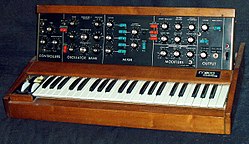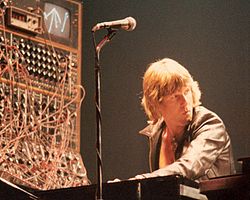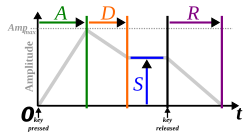Synthesizer
A musical synthesizer is an instrument that uses electricity to make musical sounds. They are the main instrument for making electronic music. Many synthesizers have a keyboard like that of a piano. When playing a piano keyboard, sounds are made by hitting soft hammers against strings pulled very tight. When playing a synthesizer keyboard, sounds are made by turning electrical oscillators on and off. Since "synthesizer" is such a big word, the word is usually shortened to "synth".
How synthesizers work
An oscillator is something that "vibrates", or repeats the same pattern. The pendulum of a clock, for example, is a very slow oscillator. A piano string "oscillates" when struck by a hammer.
Electric oscillators might be made using transistors. They turn electricity into electrical patterns, or signals, that repeat over and over. When different keys are pressed, different notes are heard. This is done by making the signal from the oscillator repeat at different rates.
The signal can be boosted in strength and sent straight to a loudspeaker. But the sound of a simple signal can be boring after a while. Sounds can be made more interesting in many ways.
- For example
- Signals are often shaped by changing how fast they get loud and then soft again. This method, called "ADSR", helps synthesizers to sound more like older instruments — pianos, trumpets, flutes, and so on.
- The signals from several different oscillators may be combined. This helps to make a richer sound.
- The signal can then be sent to one or more filters. Filters are used to take away parts of the signal. For example, they might make the signal sound "brighter" or "duller", "soft" or "harsh".
- Many synthesizers use special oscillators called "LFOs". For example, an LFO might control how loud and soft the signal is, or control the pitch of the signal. An LFO might even control the actions of the filters.
By combining many of these methods, synths can now sound very much like older instruments. For one example, special synths called "drum synths" are used just to make the sounds a drummer might make. Synths can also make many new sounds never heard before.
In the early 2000s, computers got fast enough so "software synths" could be made. These are computer programs designed to look and work like a synth. They tend to be less expensive, so more can be used. Most of these programs can be downloaded for free, however this may be illegal.
There are special tools available to play synths. For example, a thing called a "wind controller" lets players of wind instruments use their special skills. But there is still a need for more ways to control synths to make them more expressive.
Synthesizer Media
Early Minimoog by R.A. Moog Inc. (c. 1970)
Robert Moog with Moog synthesizers. Many of Moog's inventions, such as voltage-controlled oscillators, became standard in synthesizers.
The Minimoog, introduced in 1970, was the first synthesizer sold in music stores.
The Yamaha DX7, released in 1983, was the first commercially successful digital synthesizer and was widely used in 1980s pop music.
Keyboardist Keith Emerson performing with a Moog synthesizer in 1970
In subtractive synthesis, complex waveforms are generated by oscillators and then shaped with filters to remove or boost specific frequencies.
Other websites
- Sonic State describing 3000 models of Synthesizers
- Analog & Digital Synthesizers museum Archived 2007-01-22 at the Wayback Machine - Synthesizers database, resources, user reviews, pictures
- Vintage Synth Explorer - facts and photos of hundreds of old and new synths
- The history of Electronic Music
- 120 years of Electronic Music Archived 2007-07-17 at the Wayback Machine








